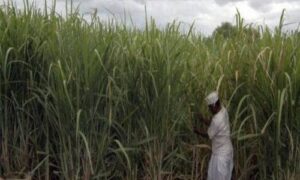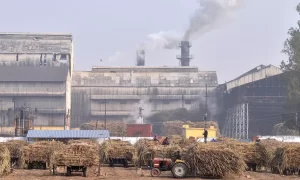How India’s sugarcane FRP hike affects farmers and mills: A Sweet deal or sour outcome?

In a significant move impacting India’s sugar industry, the Fair and Remunerative Price (FRP) for sugarcane has been increased to ₹340 per quintal for the 2024-25 season, marking a substantial ₹25 rise and the most considerable hike since 2014. But does this spell a sweet deal for farmers or a potentially sour outcome for the industry?
What Is FRP?
FRP, short for Fair and Remunerative Price, represents the minimum amount mandated for sugar mills to pay to sugarcane farmers. Set annually by the Central Government based on recommendations from expert bodies like the CACP and CCEA, FRP serves as a crucial factor in the economic dynamics of the sugar industry.
Why Did FRP Increase?
The government’s decision to elevate FRP is aimed at supporting sugarcane farmers, intending to fulfill its commitment to doubling their income. The ₹340 per quintal for the 2024-25 season is the highest increase witnessed as of now, signaling a proactive approach to bolstering the agricultural sector.
How Does FRP Impact The Sugar Industry?
The Good:
– Economic Boost for Farmers: Sugarcane farmers stand to gain with increased income, fostering prosperity and potentially boosting the rural economy.
– Encouraging Farming Practices: The higher FRP may incentivize better sugarcane cultivation practices, leading to improved crop quality and quantity.
– Biofuel Sector Support: The increased FRP aligns with the government’s goals for the biofuel sector, contributing to the target of 20% ethanol blending with petrol by 2025.
The Bad:
-Impact on Sugar Mills: The elevated production costs resulting from the higher FRP may impact the profitability of sugar mills, especially with the obligation to pay within a short timeframe.
– Potential Domestic Surplus: A surplus in the domestic market could lead to lower ex-mill and retail sugar prices due to an imbalance between supply and demand.
What is the Ethanol Restriction?
The government has imposed a temporary restriction on ethanol production, aiming to ensure an adequate supply of sugarcane and sugar in the domestic market, particularly during periods of drought and pest infestation.
How does the Ethanol Restriction Affect the Industry?
– Reduced Income from Ethanol Sales: The restriction on ethanol production translates to decreased income for the sugar industry, considering ethanol’s higher value compared to sugar.
– Challenges for Ethanol Blending Program: Achieving the 20% ethanol blending target by 2025 may face obstacles due to the temporary ban.
– Impact on Sugarcane Farmers: Farmers linked to FRP payments may experience delays and potential cane arrears due to reduced income from ethanol sales.
What is MSP and How Does it Affect the Industry?
MSP, or Minimum Selling Price, sets the lowest price for sugar mills to sell sugar in the market. Unchanged since 2019 at Rs 31 per kg, the industry advocates for an increase to at least Rs 37 per kg to cover production costs adequately.
Challenges and Consequences of MSP and FRP:
– Market Surplus Concerns: A higher FRP coupled with a static MSP may contribute to a domestic surplus, affecting the competitiveness and viability of sugar exports.
– Impact on Industry and Farmers: The industry’s income and farmers’ welfare may be at stake due to the MSP not aligning with rising production costs and market conditions.
As India navigates through these policy shifts, the delicate balance between supporting farmers and ensuring industry sustainability remains a key concern. The impact on the economy, farmers, and sugar mills will unfold in the coming months, shaping the trajectory of the sugar industry.
Understanding the Miller’s Perspective:
Suppose a miller in western Maharashtra has a recovery rate of 11.50%, meaning they can produce 11.5 kg of sugar from 100 kg of sugarcane. The FRP for the 2024-25 season is ₹340 per quintal for a base recovery rate of 10.25%. This means the miller has to pay ₹340 to the farmer for every 100 kg of sugarcane, plus a premium of ₹2.75 for every 0.1% increase in recovery above 10.25%. Therefore, the miller has to pay ₹340 + (11.50 – 10.25) x 27.5 = ₹374.38 per quintal of sugarcane to the farmer.
The cost of production for the miller is ₹374.38 divided by 11.5, which is ₹32.55 per kg of sugar. However, the Minimum Selling Price (MSP) of sugar is fixed at ₹31 per kg since 2019, creating a deficit of ₹1.55 for every kg of sugar produced. This unsustainable situation may prompt the miller to explore various strategies, such as selling at a higher market price, reducing production costs, seeking government subsidies, or loans.
The miller’s survival hinges on effectively balancing income and expenses and adapting to changing market conditions. Government intervention may become necessary, requiring potential revisions to MSP or FRP to ensure the industry’s viability and the welfare of farmers and millers. The intricacies of this economic dance will determine the future of India’s sugar industry.
Disclaimer: The views and opinions expressed in the article by Dilip Patil, Managing Director of Samarth SSK Ltd., are solely his own.
Source Link: https://www.chinimandi.com/how-indias-sugarcane-frp-hike-affects-farmers-and-mills-a-sweet-deal-or-sour-outcome/
















